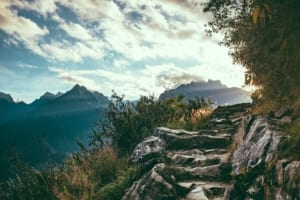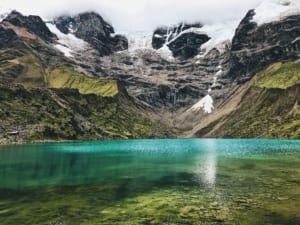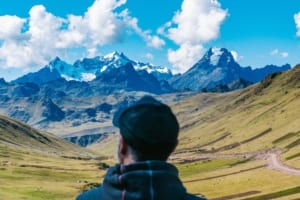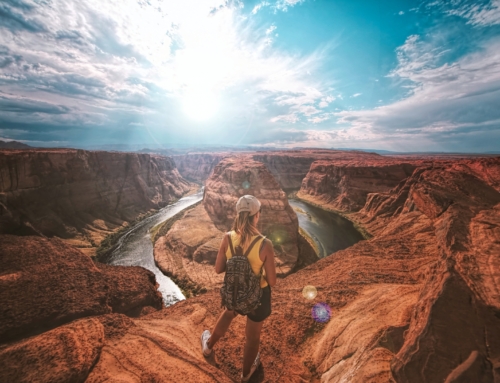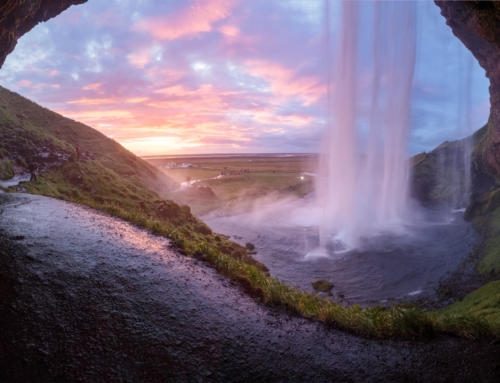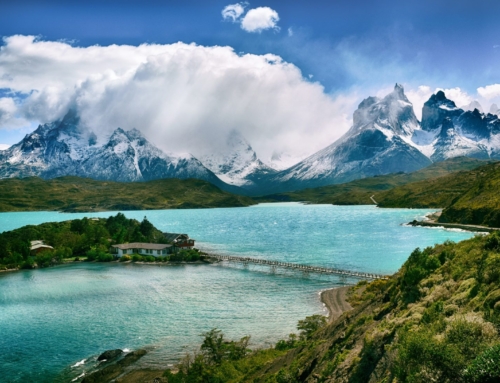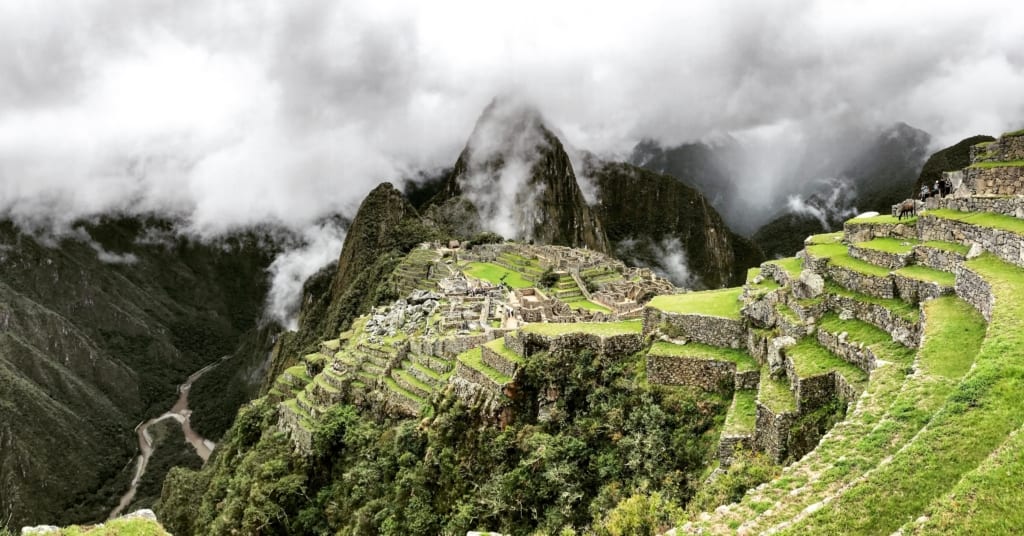
Top 9 Machu Picchu Hikes in 2024
There’s no doubt about it – Machu Picchu is Peru’s numero uno attraction and our list of top Machu Picchu hikes will get you there. Mysteriously hidden in the cloud forests of the Sacred Valley above the gushing Urubamba River, Machu Picchu has stood for over an astounding 500 years. For much of that time it was completely hidden away from humankind. That is until American explorer Hiram Bingham rediscovered the site in 1911 and travelers have been flocking to see Machu Picchu’s mystical temples and the legendary Incan Gate of the Sun since the 1970s.
These days, it’s possible to drop in for a day trip on the train, thanks to the scenic ride from Ollantaytambo to Aguas Calientes, the town that sits at the base of Machu Picchu. However, we like the more adventurous options: Machu Picchu hikes. Some hikes will whisk you through lush Peruvian jungles on trails laid centuries ago by the Incas. Other hikes will scale soaring mountain passes where you can gaze at snow-capped summits far above the clouds. And there are even shorter day hikes that offer sweeping views over Machu Picchu itself. In no particular order, let’s take a look at nine of the very best Machu Picchu Hikes.
1. Huayna Picchu

Huayna Picchu is the shark-fin of a peak that stands immediately behind Machu Picchu. You’ve probably already seen it somewhere – it’s a regular on postcards of the long-lost Incan city in the clouds. These days, Huayna Picchu is also a popular addition for those who visit Machu Picchu, offering some of the best views of the UNESCO World Heritage site and ‘New Seven Wonders of the World’ from high above.
Of our list of Machu Picchu hikes, the hike to reach Huayna Picchu isn’t the easiest out there though. It’s a steep 1,000-foot (300-meter) vertical ascent that begins on the north side of the main Machu Picchu citadel. You’ll have to get there by foot or by shuttle bus from Aguas Calientes before joining the main trailhead to Machu Picchu, which is marked by a warden’s hut. The first section of the trail goes through thick forest, peaking and troughing before there’s a sharp fork in the road. Here, you’ve got two choices for hiking this Machu Picchu hike: Go the short or the long way.
The short trail is a one-hour back-and-forth hike that zigzags straight up the front of the peak to the summit. It’s steep and has some narrow sections that require scrambling. The longer hike will take you around the back of the mountain to the mysterious Incan Moon Temple (thought to have been a royal tomb) and then up a rocky trail to the top.
The reward is a head-on panorama that takes in the slab of stone that is Phutuq K’usi in the east, the terraces of Machu Picchu below, along with the gleaming ice sheets of the Salkantay massif far on the southern horizon. There are currently two hiking slots for the Huayna Picchu trek, one at 7 am and the other at 10 am. The morning means fewer people on the route but also a higher chance of fog. The latter hike means it’s hotter, but the views are generally better. Also, it is important to note that you will need a permit to hike Huayna Picchu.
There are only 200 permits issued per day for Huayna Picchu so it is important to reserve your place well in advance of your visit to hike to this sacred mountain.
2. Machu Picchu Mountain
The namesake mountain of Machu Picchu looms over the south side of the ancient citadel. Machu Picchu Mountain is one of the highest in the immediate vicinity of Aguas Calientes, clocking up 10,112 feet (3,082 meters) above sea level. It’s also one of the less-visited Machu Picchu area day treks here, so you should encounter fewer people as you scale to the summit hut.
You’ll need to look for the guardhouse that’s on the south edge of Machu Picchu to get going. It’s along a wide dirt track that skirts the old stone terraces, around 30 minutes’ walk from the Sun Gate (Inti Punku). That’s where you show your passes and passport and begin the path in earnest.
The start is wide, paved and well maintained, but Machu Picchu Mountain quickly steepens. Soon, the hiking route hugs huge rock boulders that jut out of the side of the massif, and then passes through clusters of ancient Incan ruins that can be particularly tricky to hike after heavy rainfall. The final push of this Machu Picchu hike breaks out into more exposed areas with the views of lush green mountains rising to the east. Finally, you follow an open ridge on a dirt path all the way to the summit hut. That’s where the stunning view of the Machu Picchu citadel with Huayna Picchu behind awaits, but also where you can gaze south to snowy Salkantay.
There’s a limit of 400 trekkers per day on Machu Picchu Mountain, so be sure to book in advance for this top hike. The whole trek takes about 3 – 4 hours to complete. We’d say it’s more of a purist hike than Huayna Picchu. We feel that Machu Picchu Mountain has better panoramas of the Andes that dominate the Sacred Valley.
3. Classic Inca Trail
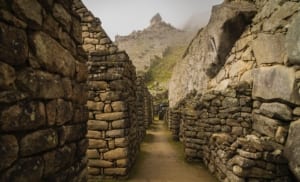
The Inca Trail is possibly the most famous trekking path on Earth. It follows a weathered route that was actually built by the Incas themselves, going all the way to the mythical temple site of Machu Picchu. Along its course, the Inca Trail passes through an area known as the Sacred Valley for its wealth of ancient sites, temple complexes and other ruins. There are multiple versions of this Machu Picchu trek, but the most popular is the Classic Inca Trail. It usually takes 4 days and 3 nights to complete.
Most Inca Trail tours start with a pick-up from your hotel in the enthralling city of Cusco, the ancient capital of the Inca Empire. A 1.5-hour drive gets you to the town of Ollantaytambo from where there’s private transportation on to the first checkpoint at KM 82. The first day of hiking is all about gaining altitude as you climb high into the Cordillera Urubamba and see the amazing Inca grain silos of Llactapata.
Day 2 of the Inca Trail hike is a real push up above the clouds. Things start in the lush highland meadows of Llulluchapampa with the mighty peak of Huayanay lurking up behind. Then you hit the highest point in the whole trail, at Dead Woman’s Pass (13,828 feet / 4,214 meters)! Day 3 goes lower, into wetter terrain where the archaeological site of Phuyupatamarca keeps watch. By day 4, you’ll be exploring the actual grounds of Machu Picchu itself, behind the iconic Gate of the Sun.
There are now pretty strict regulations on the number of people allowed to hike the Classic Inca Trail to Machu Picchu. It is important to note that passes are limited to 500 per day but only 200 of these places are allocated for trekkers. The remaining are reserved for cooks, porters, and guides so you need to book your IncaTrail trip well ahead of time. If you’re itching to learn more about this Classic Inca Trail Route to Machu Picchu, we’ve answered the top-searched Inca Trail questions.
4. Inca Trail Express Route

Tight on time? Consider the express route to Machu Picchu. It’s a one-day adventure that basically lets you hop on the iconic Inca Trail for the final segment of the traditional 4-day route. You’ll still get to check off many of the bucket-list attractions that make this such a famous path and enter the city in the clouds via the mystical Sun Gate – don’t worry about that!
Expect the day to start very early in Cusco. A transfer from your hotel doorstep to the train station in Ollantaytambo takes approximately 90 minutes. Then you’ll ride the rails to KM 104, the starting point for the Inca Trail Express Route that leads past the temples of Chachabamba and up to the incredible agricultural terraces of Wiñay Wayna (Winay Wauna).
From there, you’ll skirt around the ruins of Intipata and cross a dash of cloud forest before entering Machu Picchu itself, reaching the Sun Gate by approximately mid-afternoon. Next, you’ll take a short transfer to the town of Aguas Calientes where you’ll rest for the evening. The next day you’ll have an opportunity to explore the ruins at Machu Picchu on a guided tour.
Please keep in mind that you’ll need a permit for the 1-day Inca Trail Express Route. This is a great alternative if you’re determined to enter Machu Picchu by foot via the Sun Gate but find the longer 4-day trek is fully booked. It’s also a great option if you don’t have all that much time in the Cusco Andes but are determined to trek on what’s arguably the planet’s most legendary hiking path.
5. Salkantay Trail
If you came to the Cusco region for visions of snow-capped peaks that look like sleeping giants, the Salkantay Trail is probably the route to Machu Picchu that’s for you. Certainly one for the devoted trekkers, this trail takes at least 5 full days to complete and goes through some of the most jaw-dropping parts of the Sacred Valley. It’s more physically demanding than the Inca Trail hike, has a touch less history, but far more in the way of off-the-beaten-path highland terrain on your way to Machu Picchu.
The Traditional Salkantay Trek begins with a ramble out of Soraypampa up to the turquoise waters of Humantay Lake. The Humantay Lake sits in an amphitheatre of Andean summits, with the mighty top of Salkantay itself (20,574 feet / 6,271 meters) keeping watch from the clouds above. The next morning marks the start of the hardest part of the trek, as you gain altitude to traverse the soaring Salkantay Pass at 15,090 feet (4,600 meters). The mountains feel super-close there, the air is thin, but the views are simply spectacular.
After that high point, you’ll descend into green rainforest and meadowlands on the way to Lucmabamba. There, you’ll trek in the company of hummingbirds and alpaca herds as you trudge north hiking towards Machu Picchu. Arrival at the famous UNESCO site is kept for day 5, but most travelers opt to soak in the hot springs at Aguas Calientes before reaching Machu Picchu itself.
6. Hidden Valley Salkantay
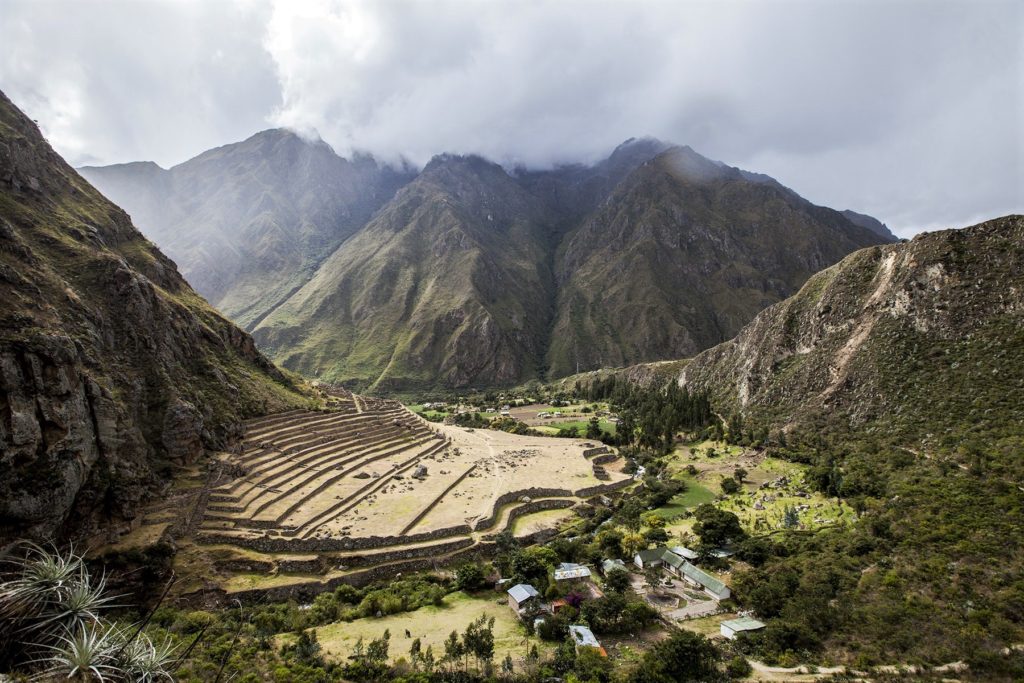
The Hidden Valley Salkantay is a variation of the classic Salkantay Trek that delves through the remote hills to the south of the namesake mountain. The focus here is on escaping the beaten path and dodging the busier routes to Machu Picchu, all while getting a flavor for how the locals of this wild, wild region live from day to day.
It begins in the traditional communities of Tomacaya. You start by clambering up through the fruit orchards to highland potato farms, where furry guanaco graze the meadows. Day two has an ace up its sleeve: The crossing of the Tocto Pass (16,072 feet up, no less!). There, majestic head-on views of Mount Salkantay, the holy peak at the epicenter of the Vilcabamba Range, explode all of a sudden.
The next day is about exploring the valleys of Pampacahuana and Qesca, which have been frozen in time for centuries. They’re still inhabited by real Incan communities of weavers and potato growers, who live in rustic villages with spectacular settings beneath the snowy summits. As you head north towards the main Inca Trail, there’s a chance to visit the iconic Llactapata ruins and Incan-era agricultural terraces. Then you connect with the classic route to make it to Machu Picchu proper.
7. Vilcabamba Traverse
If you seek challenge in your hike to Machu Picchu, this is the trial for you. While the crowds of travelers flock to the famous Classic Inca Trail and the sights of Salkantay, the Vilcabamba Traverse remains firmly out of the spotlight. This is the Machu Picchu trek to take if you’re really looking for a remote and rugged adventure experience. The Vilcabamba is stunningly beautiful, doesn’t require a permit, and treks through some of the most unexplored parts of the Sacred Valley. Sold? Let’s take a look at what’s involved in the hike…
The Vilcabamba Traverse hike begins with a sort of loop around the mighty Nevado Veronica massif. You’ll go from the winding Urubamba River to the dusty canyons of the Abra Malaga highlands by car. Boots laced, you’ll then descend into the Chaullay Valley, a hidden land of verdant meadows and fascinating pre-Columbian religious sites like Ñusta Hispana (the mysterious White Rock). The second day of this journey to Machu Picchu joins historic Incan roads that carry you higher and higher to reveal rock-ribbed summits soaring from flourishing rainforests.
Day 4 is the real jewel in the crown of the Vilcabamba Traverse. It’s also by far the most challenging part of the trek. It involves a trio of uber-high passes, starting with Yanococha (14,501 feet / 4,420 meters), then hitting Tullu Tacanca (14,763 feet / 4,500 meters), and finally topping out at Mojon (14,796 feet / 4,510 meters). Views on this day of the hike are unsurprisingly spectacular, including some glimpses of Huayna Picchu and colossal Salkantay, but also the eastern Andes that rise nearer Lares and Chicón.
The Vilcabamba Traverse then shifts to the west. It runs through some lower terrain filled with passion fruit farms and coffee plantations (you won’t be short on a drink during your hike!). One warning: It’s the hardest Machu Picchu trek on this list and requires good fitness levels to hike.
8. Lares Trek
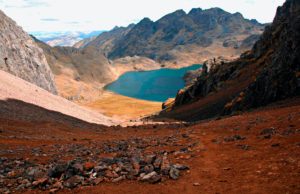
Often overlooked in favor of the more famous Inca Trail and the wilder Salkantay Trail, the Lares Trek is a real adventure in its own right. It takes you through the namesake Lares Valley on the more undiscovered eastern haunch of Machu Picchu. This is a place steeped in local tradition; a land of hardy alpacas and weaver communities where the first tongue is Quechua. Although no permits are required to hike the Lares route, you don’t have to worry about crowds – the trail is all about escaping the footfall of other paths in the region.
Usually taking 3 days, the trip begins with a long bus out of Lares village to a trailhead below the pass of Huilquijasa. It’s a challenging start, pushing you over 13,779 feet (4,200 meters) above sea level to a plateau that’s dotted with shimmering lakes. It’s a steep descent from there on the second day into a land of forgotten villages surrounded by icy peaks. Then you need to conquer the highest point, which actually pushes above 15,400 feet (4,694 meters). The last leg takes you over to Ollantaytambo, where you can rest up before exploring Machu Picchu itself.
The most popular version of the Lares Trek is often called Weavers Way. That’s because it includes a pitstop in the sequestered valley of Huacawasi, a place of age-old craft communities that still live by Incan traditions. It’s considered the most culturally rich choice of all Machu Picchu hikes and is still relatively unknown.
9. Ancascocha Trek

The Ancascocha Trek is a wonderful off-the-beaten-path trail that has been recognized by National Geographic. It’s one worth considering if you like a challenge. Its less-crowded path zigzags around the mountains to the east of Machu Picchu, sometimes crossing the Classic Inca Trail but largely limited to the lesser-known sections and valleys of the Cusco Andes.
Along the way, you’ll soar through a whopping seven passes to clock up over 15,200 feet (4,600 meters) during loads of variable up-and-down hiking. On days one and two, your stamina will be pushed to the limit as said passes seem to come one after the other in quick succession. First, it’s up to Kuychiccasa Pass (14,599 feet / 4,450 meters), where the snow-capped Andes frame rustic Peruvian farms on the highland plateaus. Then, you conquer the soaring Huayanay Pass (the highest point of the trek at 15,255 feet / 4,650 meters). There are waterfalls and condor nesting sites to see as you go, too.
Hikers get to camp in the remote Quesqa Valley. Cut off from the modern world by a phalanx of crumpled massifs, it’s a lost world of dancing tussock grasses and reflective alpine lakes where there’s rarely another soul around. After that, the route connects with the main Inca Trail route (which might be the first place you encounter other hikers) and then returns to the Urubamba Valley at KM 82, putting you in a great place to hop on the trains bound for Machu Picchu itself.
We hope you are excited to embark on an adventure tour to the Sacred Valley and that you’ve enjoyed this guide on the Top 9 Machu Picchu Hikes. If you did, you’ll also love that we created the Internet’s most comprehensive Guide to Hiking the Inca Trail to Machu Picchu to help you prepare for a truly epic hike. Be sure to also check out the best places to visit in the extraordinary country of Peru and get in touch with us for more information on planning your dream tour.
I look forward to hiking with you soon!
Cheers,
Jeff
Jeff Bonaldi
Founder & CEO
The Explorer’s Passage
About Jeff Bonaldi
Jeff Bonaldi is the Founder and CEO of The Explorer’s Passage, a premier adventure travel company. His mission is to provide travelers with the opportunity to transform their lives and the planet through the power of adventure.
Learn more about Jeff’s story and his company HERE.


